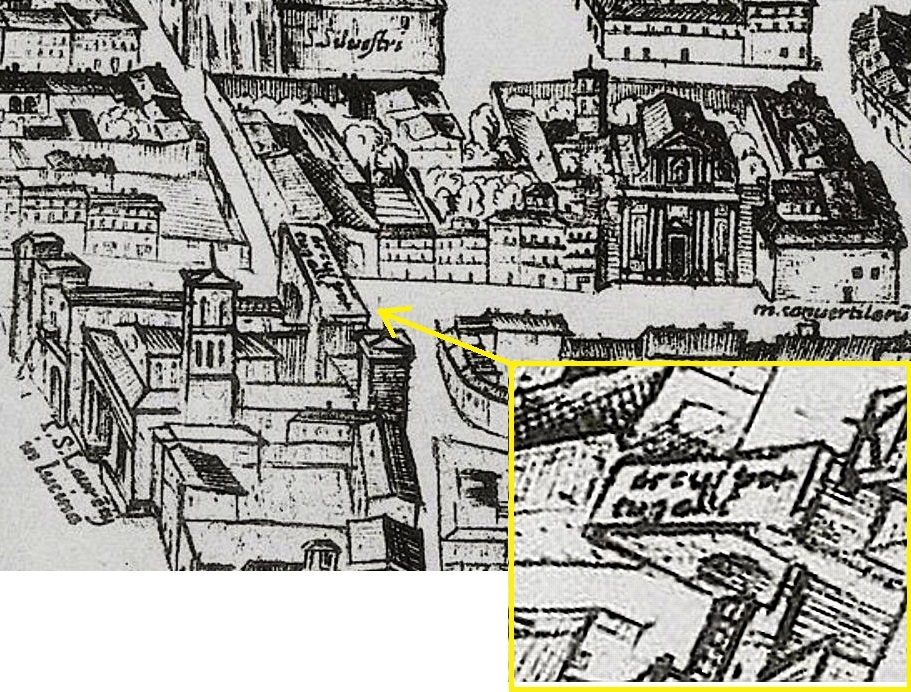
`And when we were discussing the location of the former Arco di Portogallo on the Via Flaminia/ Via Lata/ Via del Corso, which was destroyed in 1622, Franz Xaver Schütz has made a relevant research and found a hitherto not recognized representation of the former Arco di Portogallo on Tempesta's bird's-eye-view map of Rome (1593; cf. here Fig. 64.1)´. Antonio Tempesta has even labelled this Arch: "arcus por / tugalli". See the inserted box on here Fig. 64.1, with the enlarged detail of Tempesta's map with the labelled Arco di Portogallo, which we have turned around, so that the inscription is legible."
"In the following, I should like to mention again this Arch of Hadrian 434 at Rome, to which Hadrian's adventus relief in the Palazzo dei Conservatori (here Fig. 91) once belonged, because some scholars confuse it with the former Arco di Portogallo, which stood likewise on the Via Flaminia/ Via Lata/ Via del Corso. But contrary to this former Arch of Hadrian, that I am referring to here, which stood right in front of the (later) Hadrianeum, and on the west side of the Via Flaminia/ Via Lata/ Via del Corso, and parallel to it, the former Arco di Portogallo had actually bridged this road. The Arco di Portogallo stood until 1662, when it was destroyed, circa 358 m435 to the north of this Arch of Hadrian, and at the same time very close to the original location of the Ara Pacis Augustae. An inscription at a Palazzo on the east side of the Via del Corso436 indicates the approximate location of the former Arco di Portogallo. I have elsewhere summarized the discussions related to this Arch of Hadrian alongside Via Flaminia and to the Arco di Portogallo437 and have marked the former locations of both arches on the maps that accompany my texts.
Cf. here Fig. 58; 59, labels: VIA FLAMINIA/ VIA LATA/ Via del Corso; Via della Vite; Approximate location of the Arco di Portogallo; Via in Lucina; Via di Pietra; Arch of Hadrian438.
It has always (but erroneously) been assumed that no historical maps of Rome are known, in which the still standing Arco di Portigallo is represented. Franz Xaver Schütz has made a relevant research and found a hitherto not recognized representation of the former Arco di Portogallo on Antonio Tempesta's bird's-eye-view map of Rome (1593; cf. here Fig. 64.4 [corr.: 64.1]).
The reason for the confusion just mentioned (of the Arch of Hadrian in front of the later Hadrianeum discussed here with the Arco di Portogallo) is the fact that two other Hadrianic reliefs, the so-called adlocutio relief of Hadrian (here Fig. 91) 439, and the representation of the apotheosis of Hadrian's wife Sabina (here Fig. 92) 440, had both been reused in late antiquity as decorations of the Arco di Portogallo. Following Ferdinando Castagnoli and Michaela Fuchs 441, I have in my earlier Study (2017) suggested that all three Hadrianic reliefs mentioned here at the Palazzo dei Conservatori: Hadrian's adventus, here Fig. 91 (and the two reliefs that, in late antiquity, had been reused at the Arco di Portogallo, here Figs. 92; 93), plus a fourth Hadrianic relief at the Palazzo Torlonia (here Fig. 94), had originally belonged to this Arch of Hadrian that stood right in front of the (later) Hadrianeum .
--------------434 for this Arch of Hadrian, cf. M. FUCHS 2014..
435 measured on my map Fig. 3.7 of the Campus Martius; cf. C. HÄUBER 2017, 63, Fig. 3.5 [= here Fig. 58], p. 69, Fig. 3.7 [= here Fig. 59]. For that, cf. supra, n. 66, in Chapter I.1.
436 for a photograph of this inscription, cf. C. HÄUBER 2017, Fig. 3.5.1 on p. 65. The Palazzo, into which it is inserted, stands on the east side of the Via del Corso, between the junctions of Via del Corso and Via della Vite and Via del Corso and Via in Lucina.
437 for the former Arco di Portogallo, cf. C. HÄUBER 2017, 111-112, n. 56; map Fig. 3.5, cf. pp. 62-63; map Fig. 3.6, cf. pp. 66-67; map Fig. 3.7 [= here Fig. 59], cf. pp. 68-69; map Fig. 3.8, cf. pp. 104-106; map Fig. 3.9, cf. pp. 108-110; map Fig. 3.10. Some scholars regard the former Arco di Portogallo as a gate in the sacred boundary of Rome, the pomerium; cf. Häuber (2017, 111, n. 56, pp. 351-352 with n. 136, pp. 583-584, n. 306).
438 the former locations of the Arch of Hadrian and of the Arco di Portogallo are both visible on my maps Fig. 3.5 [= here Fig. 58] and Fig. 3.7 [= here Fig. 59], labels: VIA FLAMINIA/ VIA LATA; Via del Corso; Via della Vite; Approximate location of the Arco di Portogallo; Via di Pietra; Arch of Hadrian. For those maps, cf. supra, n. 66, in Chapter I.1.
439 for the so-called adlocutio relief of Hadrian, cf. C. HÄUBER 2017, 20-21, 23, 111-112, n. 56; p. 250, Fig. 5.9 [= here Fig. 91]; cf. pp. 520-521.
440 cf. C. HÄUBER 2017, 20-21, 23, 111-112, n. 56, pp. 242, 246; p. 249, Fig. 5.8 [= here Fig. 92], the relief showing the apotheosis of Sabina, p. 521.
441 CASTAGNOLI 1942, 76-77, 82, Fig. 1; M. FUCHS, 2014, 131-144, Figs. 12-23; cf. C. HÄUBER 2017, 20-21, 242, 245-246."